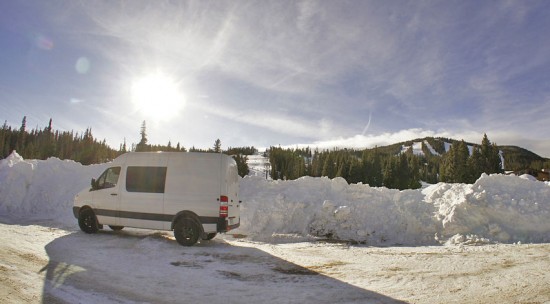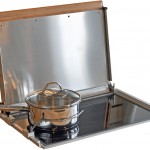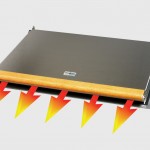 Lately a number of readers of the blog and my Sprinter RV Conversion Sourcebook have asked me about heaters and stoves for their Sprinter conversions, and why I chose to go the diesel route. So here’s some of my answers as fodder for your own design decisions…
Lately a number of readers of the blog and my Sprinter RV Conversion Sourcebook have asked me about heaters and stoves for their Sprinter conversions, and why I chose to go the diesel route. So here’s some of my answers as fodder for your own design decisions…
If you are planning a DIY Sprinter conversion, you might want to build a simpler camper that will meet all your needs, but take less time and money to build and maintain. To me, that meant a one-fuel approach, doing without a propane system and relying on diesel fuel for cooking and heating. This approach also might help you if you plan to take your Sprinter campervan on long road trips or expeditions, where it’s easier to manage just one fuel source. In practice, this means you’ll need a diesel-powered 12V DC heater and cooktop, which are common for European motorhomes and North American boats, but not North American RVs.
Diesel Heaters for Your Sprinter
The Espar Airtronic D2 and the Webasto AirTop 2000D are both common, compact diesel-powered 12V forced-air heaters that work well for a one-fuel solution with the turbodiesel Sprinter van. Of course, there’s the question of how much heat these heaters put out. I have a high-roof 144″ Sprinter camper, so either would be adequate for my needs, but one reader asked “would the D2/AT2000 adequately heat an insulated Sprinter 170″ camper?” Two answers:
- The subjective answer – I personally need quiet to sleep, so even though our Wallas 85DU/270 cooktop/heater puts out a fair bit of heat, if it’s really cold, I end up turning it off for the same reason I turned off my propane furnace in my older van: the fan noise keeps me awake, so I prefer to sleep in silence in a warm sleeping bag.
- The more-objective answer – if you want to know for sure exactly how your heater will perform, take its technical specs (say for the Espar D2, its larger cousin the D4, or the Webasto AT2000) and input them into this heating performance calculator.
Diesel Cooktops for Your Sprinter
Diesel cooktops are pretty rare beasts in North America, though that may be changing soon as Wallas/Webasto bring more dealers online this side of the pond (the Finnish firm Wallas licenses the design to the German company Webasto). Readers ask:
“Any problems/inconveniences with the stove function? (Warm-up time, both burners in use all the time?). Does one need iron-based cookware for this to work?”
The biggest problem I’ve found with our Wallas 85DU/270 diesel cooktop is altitude: much of our camping is in the mountains of Colorado above 8000 feet, and the Wallas (unlike the Webasto X100, which has an altitude adjustment) is designed for sea-level use on a boat. Mine requires multiple starts at high altitude, and still dies even after several minutes of operation. Near home (6000 ft ASL), it starts and runs just fine. It does take about 7-10 minutes to warm to max heat, and there is only one knob to adjust both burners, the left is always hotter than the right. It doesn’t need any special cookware to work (we use standard stainless pots), although you’ll want to ensure that your cookware has a smooth flat bottom for best heat conduction. You’ll want to ensure that no windows are open on the side of the van where the stove exhaust is, since it’s diesel exhaust smoke, after all.
The images below show the 85DU/270 cooktop in (left picture) cooking position with a pot on the hottest burner, and (right picture) in heating position with the blower lid down, arrows showing the flow of hot air.
 |
 |
“Most importantly, would you make the purchase again? After reading your book, I am intrigued by a “one-fuel” ride. I found the 85DU for about $2000 for a lightly-used 2010 model and I could use a push in the right direction.”
I still value the convenience of the one-fuel approach, but given my experience, I would set up my next camper with a Webasto X100 cooktop (RV version of the Wallas 88DU) and Webasto AirTop 2000D (or Espar Airtronic D2). This would enable me to mount the heater somewhere close to the sleeping area and at a level below it, so the heat doesn’t just wind up in the top of the van (and you really want to ensure that you have good insulation in the roof to retain some of the heat!). The X100 is standard-issue on European all-diesel RVs, and their heaters are typically the more versatile and cost-efficient air & water-heating Webasto DualTop/Espar Combitronic D/Truma Combi designs, which aren’t commonly available in North America yet either.
ASKING YOUR FEEDBACK: Are you considering going the one-fuel route with your Sprinter conversion? If so, what’s the biggest reason why (or why not)?




Comments on this entry are closed.